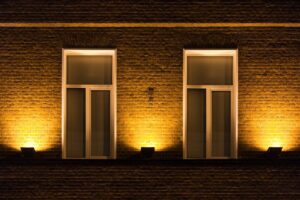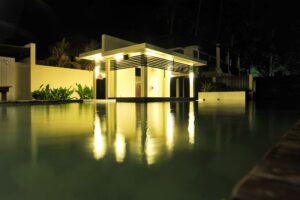In this blog, we talk a lot about landscape lighting techniques. However, as much as we appreciate the art of landscape lighting, homes are not public parks, and residential outdoor lighting is about a lot more than trees and bushes. That’s why we wanted to dedicate a full blog post to outdoor wall lighting. If you think about it, walls are the largest features in your entire outdoor lighting system. The walls of your home take up more space than any other single element. So it’s a shame that so little time is spent discussing outdoor wall lighting. Knowing how to light a wall is just one of the many skills that set Night Vision Outdoor Lighting apart from the competition. You’ve got to start by doing the simple things right, which is why we put more time and energy into outdoor wall lighting than you would ever imagine.
![Outdoor Wall Lighting [infographic]](https://nvlightingga.com/wp-content/uploads/2019/01/Outdoor-Wall-Lighting-infographic-1.jpg)
What Is Outdoor Wall Lighting?
There’s a simple answer to this question and a much more nuanced answer. The simple answer is that wall lighting is any lighting that shines on your walls. However, the details of wall lighting are much more interesting than that.
Wall lighting is the art of how to light walls to show them off. You may think that there isn’t much to a wall. It’s an afterthought. But walls should never be an afterthought. If you plan on lighting your home, walls should be one of the first features you consider. How you light your walls will set the tone for the rest of your lighting system. Often, outdoor wall lighting serves as a background or base for all your other outdoor lighting. Get it wrong, and your whole project is thrown off. But get it right, and your home comes to life with spectacular interest.

Outdoor wall lighting can be tricky to get right.
Outdoor Wall Lighting Challenges
There are some challenges to outdoor wall lighting. Dark, smooth, shiny walls are the hardest to light, but it’s not impossible.
One of the biggest challenges with outdoor wall lighting is finding the right balance between providing enough light while also avoiding glare or overly bright lights. This can be especially challenging when using up-lighting or down-lighting since these types of outdoor lighting are very directional in nature.
Another pitfall to look out for when designing your outdoor wall lighting is the dreaded light bomb. A light bomb is a light that is so bright compared to the surroundings that it overwhelms your dark-adjusted eyes. The light bomb temporarily blinds you to everything darker around you. It’s the same effect you get when you walk out of a dark room into a bright sunny day. But it’s not an effect you want to create intentionally. (Learn more about the ideal brightness for outdoor lighting here.)
Glare is another pitfall to avoid. It is closely related to the light bomb. However, instead of blinding you like a light bomb, glare prevents you from looking at a specific spot that is too bright for your dark-adjusted eyes.
Other common mistakes include improper use of wall washing and wall glazing. We’ll cover all of these in detail in the following sections.

Wall washing is an outdoor wall lighting technique that adds a lot of light t a space.
Wall Washing
Wall washing—often referred to as wash lighting—is a method of lighting that covers a large area with light. It is best used on large, mostly flat walls. The name washing refers to a few different aspects of this lighting technique. First, you are washing over the whole wall with light. The light goes everywhere. Second, the effect of wash lighting is to wash out any small imperfections in the wall and make it look flat and smooth.
When to Use Wall Washing
- Wall washing is an outdoor wall lighting technique best suited to large areas without much textural interest.
- One of the main goals of wall washing is to eliminate shadows, which creates a blank canvas for the rest of your outdoor lighting.
- Wall washing is most effective on light-colored walls with a matte texture.
- If you want to give the impression that a wall is larger than it is, wall washing is a great technique. By flattening out shadows and imperfections, it can make a wall look like a more open expanse.
- Wall washing is a type of outdoor wall lighting that can also serve as a type of indirect ambient lighting for the areas nearby, like porches, patios, and decks. A lot of the light from wall washing will reflect back and light the surrounding area.
When Not to Use Wall Washing
- Wash lighting won’t do much for a very dark wall.
- If a wall is especially shiny—for example, a wall of polished stone—wash lighting runs the risk of massive glare. A dark, shiny wall at night can become a giant mirror, reflecting the bright wash lights right into the eyes of any unfortunate bystander.
- Don’t use wall washing on a textured wall. It will cut out shadows and wash out the detail of the texture.
How to Create Wall Washing
Wall washing uses multiple wide-angle lighting fixtures to create a bright, shadowless expanse. Floodlights or other wide-angle lights should be placed no less than 12 inches from a wall, though often more distance is appropriate. If you are illuminating a wall that is less than 9 feet, we suggest placing lights 2 to 3 feet from the wall. If the wall is 9 to 11 feet tall, add an extra foot to the distance from the wall. For multistory wall washing, you will need to go even farther back and use multiple lights to cover a vertical expanse.
Wall Grazing
When we think of grazing, the first thing that pops into most people’s mind is cattle grazing in a grassy field. It’s not a surprising association, considering that it is the oldest meaning for the wording, dating to at least the 12th century. However, when we talk about grazing something with light, we are using a more recent sense of the word. Starting in the 17th century, grazing took on the additional meaning of touching something lightly in passing. And that is precisely what you want your light to do when you use wall grazing.
Instead of lighting up the whole wall from edge to edge—as you would with wall washing—wall grazing requires the light to shine almost parallel to the surface of the wall, barely touching it as it shines upward (or occasionally downward). The light catches the slightest details of the wall’s texture, shining on one side of a bump while leaving the other side dark. The resulting light and shadow amplify the texture and show it off.
Although wall grazing refers specifically to walls, grazing is perfect for any textured surface. Natural stone columns, trees with thick bark, and even rough concrete surfaces can take on a whole new life with light grazing.
Avoid a Wall Grazing Fail
Wall grazing is a great outdoor wall lighting technique to highlight texture. However, wall grazing can be misused to disastrous effect. Here are some tips to avoid a wall grazing fail.
- Never use wall grazing on a wall that has overhangs or large protrusions. They will block the light and create large, dark shadows.
- Don’t use too much light. Overly bright wall glazing can wash out the details and make your texture look flatter than it is.
- Don’t use too little light. You need enough light to travel the length of your wall, column, tree, etc.
- A good rule of thumb is 100-150 lumens for up to 10 vertical feet, 150-200 lumens for 10-20 vertical feet, and 200-300 lumens for 20-30 vertical feet.
To achieve the full effect of wall glazing, the light fixtures need to be really close to the wall, ideally no more than 12 inches away. The light should shine almost parallel to the wall, slanted only as far as it takes for the light to catch on the texture and create shadows.
The Benefits Of Professional Outdoor Wall Lighting
Both wall washing and wall grazing outdoor wall lighting techniques have a lot of potential pitfalls. When used correctly, they can create spectacular results. But if you do it poorly, you risk undermining one of your lighting system’s largest features. So, as in all things, practice makes perfect. Luckily for you, Night Vision Outdoor Lighting has a lot of practice with outdoor wall lighting.
Just how much practice does Night Vision Outdoor Lighting have? We have installed outdoor lighting on more than 5,000 homes over more than 20 years in business. So when it comes to your outdoor wall lighting, we’re not just playing it by ear. When you work with Night Vision Outdoor Lighting, you benefit from tens of thousands of man-hours spent working on outdoor lights. Your outdoor wall lighting and every other aspect of your outdoor and landscape lighting will be perfect. So contact us today to set up your free, no-obligation consultation.



